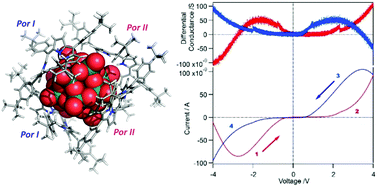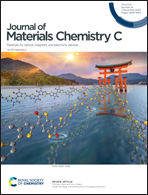Structure determination and negative differential resistance of tetraarylporphyrin/polyoxometalate 2 : 1 complexes†
Abstract
Single-crystal X-ray crystallographic analyses of two kinds of [tetraarylporphyrin]22+/[polyoxomatalate]4− (POM, SV2W10O40) complexes showed that the porphyrin and POM make three-dimensional polymeric structures, and no discrete molecular structure of [porphyrin]2[POM] units was identified. Although the two components (porphyrin and POM) can be dissociated in solution, thin films made by casting the solution partially retained the crystallographic structure, as judged from the reflection spectra and X-ray powder diffraction. A thin film of the complex between electrodes with a gap of 2 μm showed good conductivity, whereas the porphyrin and POM components separately measured under the same conditions were insulating. The I–V curves of the complex showed negative differential resistance (NDR), which can be explained by (1) conduction switching at a certain bias voltage and (2) the slow response of the conductance switching in the voltage scan time range. The increased conduction at a higher bias voltage was confirmed by AC impedance spectrometry. This is a new proposal for a mechanism of NDR phenomena.



 Please wait while we load your content...
Please wait while we load your content...